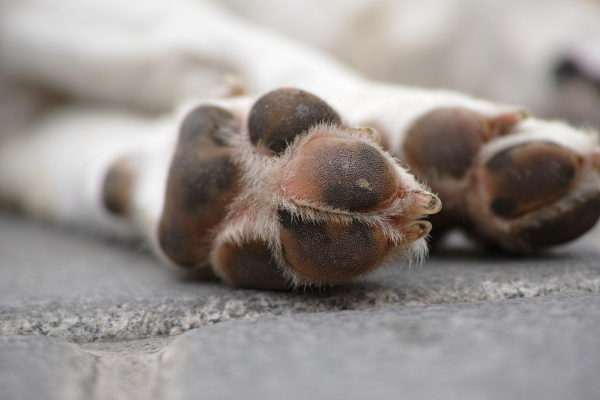Hot Asphalt is No Good for Dogs’ Paws.
Dogs are not only at risk of overheating in summer. High temperatures might also burn their paws, if we let them walk on hot surfaces.
There may be more causes of dog fear. And the first step to eliminate it is to find out its origin and cause.


Innate fear
The so-called innate deprivation is a form of fear which appears mainly in wild and semi-wild dogs. In everyday life, you encounter it most often in animals from puppy farms, which particularly the Eastern Europe is infamous for. Puppy farms are a world where the law of the pack applies, dogs breed here and grow up without any human oversight. In these individuals, an important role is played by the nature of the dog parents. Since shyness can be inherited even after several generations.
Dogs with innate deprivation are adapted to a life in a pack. They don’t care for human contact, they don’t know it, they shiver when touched by a human and they try to avoid it, often even by biting. They don’t respect humans and that’s why they also don’t listen. Even such dogs can be socialised under the hands of experts, but it’s a lengthy and a very stressful process for such dog, that doesn’t always work.
There are organisations around the whole world, that take dogs that aren’t placeable to families in to spend the rest of their lives there. They are put into a pack and they can live in peace in a fenced area outdoors.
There is a greater chance of socialisation of dogs with innate fear in puppies. However, you have to start early and the dog doesn’t always lose its fear completely.
Acquired fear
In addition to innate fear, dogs can also have acquired fear. That is such, that the animal obtains through torture, shock (a bad experience) or bad socialisation at puppy age. Between the sixth and twelfth week of age, the dog creates patterns of behaviour that it then uses for whole of its life. Therefore, it’s necessary to make it familiar at this age with as many things and situations as possible. If the dog is kept in isolation, it won’t get experience with people, other dogs and other animals, situations, smells, sounds and the like. In the future, it will react with suspicion, fear or aggression.
Fear can be acquired by a dog even from bad upbringing, unconscious behaviour. If the dog is, be it from any reason, timid, it needs a firm support from its master. That is a fearless and unquestionable leader of the pack. It’s important not to calm and stroke the dog in a situation in which it’s afraid. This would strengthen its belief, that it’s fear is justifiable. Such dog will most benefit from clear rules, training of basic controllability and a self-confident master.
Have you encountered fear in a dog? How did it look like and how did you handle the situation?


Dogs are not only at risk of overheating in summer. High temperatures might also burn their paws, if we let them walk on hot surfaces.


Besides FIP and FIV, FeLV is another fatal virus disease of cats. It is often called cat leukaemia because leukaemia is one of the common symptoms of the disease. How can your cat get infected, how can you recognize and treat it?


The Abyssinian is a short-haired elegant creature with a strong personality and history going back to the ancient Egypt. It wants to be a rightful family member and you won’t get enough of its thick, silky fur.


If you are looking for a very social breed, you have already found one. The Japanese Chin takes the role of a companion as its life’s mission. This mini dog is joyful, playful and obedient companion for both children and adults.


Would you like to give the best to your dog but there is so many brands and types of cans on the market that you get confused? I’m coming with a few tips how to choose, what shouldn’t be missing in the can and what shouldn’t be there at all.


Relationships between a cat and a dog can be difficult. Some of them might be companions for life, others are mortal enemies. This is a story of our pack which consisted of various characters but we have always somehow managed living together.


In summer, we throw off one piece of clothes after another. Especially in the last few years when the temperatures go up to tropical values. You may say that the fur of your pet must be terrible and it will be better to cut it. Is that really true?


Many adventures await a cat outside and hopefully even a few cat friends. However, also various dangers might be there as well. What can happen to a cat outdoors?


Not only dogs and cats communicate with us non-verbally. Even rabbits tell us what and how they feel with their non-verbal expressions such as postures, gestures and sounds. It helps us understand what mood they are just in. Let’s look at expression...


You can get natural variants of antiparasitic agents to you dogs as well or you can make them at home. What are their benefits and their downsides?


It is a well-known fact that cats love bright and warm spots, they like to relax on warm windowsills. Therefore, even though they are famous sleepyheads, they get new energy with the spring coming, they are more active, more sociable and more joyful....


FIV is a feared viral infectious disease of cats. It causes a slow disruption of immune systems, similarly to human virus called HIV. What is the cause and the progress of this malicious disease and what does its terminal stage look like?...